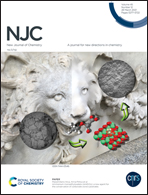Two-dimensional van der Waals graphene/transition metal nitride heterostructures as promising high-performance nanodevices
Abstract
Graphene-based van der Waals (vdW) heterostructures have attracted much attention because they can enhance the properties of separated materials, possess numerous new phenomena and unusual properties and improve the performance of devices. Motivated by the successful fabrication of single-layer transition metal nitrides (TMNs) [Science, 2020, 369, 670], we investigate the interfacial properties of heterostructures formed by stacking graphene (GR) on two different TMN monolayers, MoGe2N4 (MGN) and MoSi2N4 (MSN). Both the GR/MGN and GR/MSN heterostructures are characterized by weak vdW interactions, which preserve the intrinsic electronic properties of both the GR and TMN monolayers. The GR/MGN heterostructure forms an n-type Schottky contact, while a p-type Schottky contact is formed at the GR/MSN interface. Both the barrier and contact types in the GR/MGN heterostructure are sensitive to the electric gating and interlayer coupling. The transformation from an n-type Schottky contact to a p-type one or to an n-type ohmic contact can be achieved in the GR/MGN heterostructure by applying electric gating. In addition, adjusting the interlayer spacings between the GR and MGN layers leads to a transition from n-type to p-type Schottky contact. Our findings demonstrate that the GR/TMN heterostructures can be considered as promising high-performance nanodevices.



 Please wait while we load your content...
Please wait while we load your content...